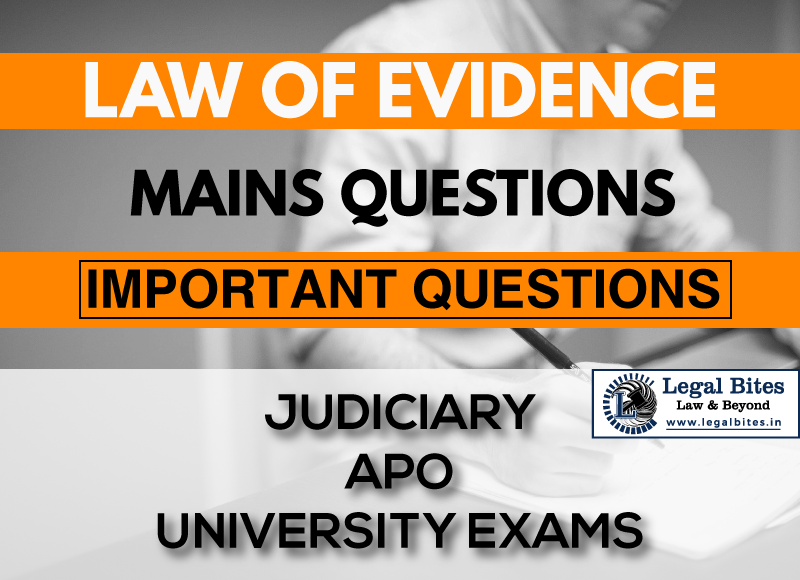Define 'Evidence'. Discuss the relationship of the Law of Evidence with substantive and procedural law.
Find the answer to the mains question only on Legal Bites.

Question: Define 'Evidence'. Discuss the relationship of the Law of Evidence with substantive and procedural law.Find the answer to the mains question only on Legal Bites. [Define 'Evidence'. Discuss the relationship of the Law of Evidence with substantive and procedural law.]AnswerEvidence in the context of law refers to the information, facts, or proof presented in a legal proceeding to establish the truth or falsity of a particular claim, assertion, or issue. It serves as the means by...
Question: Define 'Evidence'. Discuss the relationship of the Law of Evidence with substantive and procedural law.
Find the answer to the mains question only on Legal Bites. [Define 'Evidence'. Discuss the relationship of the Law of Evidence with substantive and procedural law.]
Answer
Evidence in the context of law refers to the information, facts, or proof presented in a legal proceeding to establish the truth or falsity of a particular claim, assertion, or issue. It serves as the means by which parties in a legal dispute prove or disprove facts and arguments before a court or other adjudicative body. Evidence can take various forms, including documents, witness testimony, physical objects, expert opinions, and more. The primary purpose of evidence is to assist the trier of fact (usually a judge or jury) in reaching a just and informed decision in a case.
The Indian Evidence Act of 1872 states that “Evidence” refers to all declarations made in court by witnesses regarding the facts being investigated. Documentary evidence includes both spoken comments like these and any documents made for the court’s consideration, including electronic recordings.
Relationship of the Law of Evidence with Substantive and Procedural Law:
The law of evidence is a crucial component of the broader legal system, and it has a close relationship with both substantive and procedural law:
a. Substantive Law:
Substantive Law refers to the body of law that defines and regulates the rights and obligations of individuals or entities. It sets forth the rules and principles governing various legal relationships and matters. Substantive law creates and defines legal rights and liabilities. For example, criminal statutes that specify what constitutes a crime and the associated penalties are part of substantive law.
The law of evidence is closely related to substantive law because it plays a critical role in determining whether the elements of a legal claim or offense have been satisfied. In civil and criminal cases, evidence is presented to prove or disprove the essential facts and elements required to establish liability or guilt. In other words, evidence is used to determine whether the substantive law has been violated or upheld.
For instance, in a criminal case, the prosecution must present evidence to prove beyond a reasonable doubt that the defendant committed the elements of the crime as defined by substantive criminal law. The defense, on the other hand, may present evidence to counter these claims or raise affirmative defenses, all within the framework of the law of evidence.
b. Procedural Law:
Procedural Law governs the rules and processes by which legal proceedings are conducted. It outlines the procedures and steps that must be followed in various types of legal actions, including civil and criminal trials, administrative hearings, and appeals.
The law of evidence is a crucial component of procedural law because it establishes the rules and guidelines for the presentation, admissibility, and evaluation of evidence in legal proceedings. These rules ensure that evidence is collected and presented in a fair, reliable, and consistent manner, promoting the integrity of the legal process.
Procedural rules related to evidence address matters such as the examination of witnesses, the authentication of documents, the burden of proof, and the admissibility of certain types of evidence. These rules help maintain order in the courtroom and ensure that both parties have a fair opportunity to present their case.
In summary, the law of evidence bridges the gap between substantive law (which defines rights and liabilities) and procedural law (which governs legal processes). It is a fundamental aspect of the legal system that ensures that facts are established, contested, and evaluated in accordance with established rules and principles, ultimately contributing to the fair and just resolution of legal disputes.
Important Mains Questions Series for Judiciary, APO & University Exams
- Law of Evidence Mains Questions Series Part-I
- Law of Evidence Mains Questions Series Part-II
- Law of Evidence Mains Questions Series Part-III
- Law of Evidence Mains Questions Series Part-IV
- Law of Evidence Mains Questions Series Part-V
- Law of Evidence Mains Questions Series Part-VI
- Law of Evidence Mains Questions Series Part-VII
- Law of Evidence Mains Questions Series Part-VIII
- Law of Evidence Mains Questions Series Part-IX
- Law of Evidence Mains Questions Series Part-X

Mayank Shekhar
Mayank is an alumnus of the prestigious Faculty of Law, Delhi University. Under his leadership, Legal Bites has been researching and developing resources through blogging, educational resources, competitions, and seminars.

